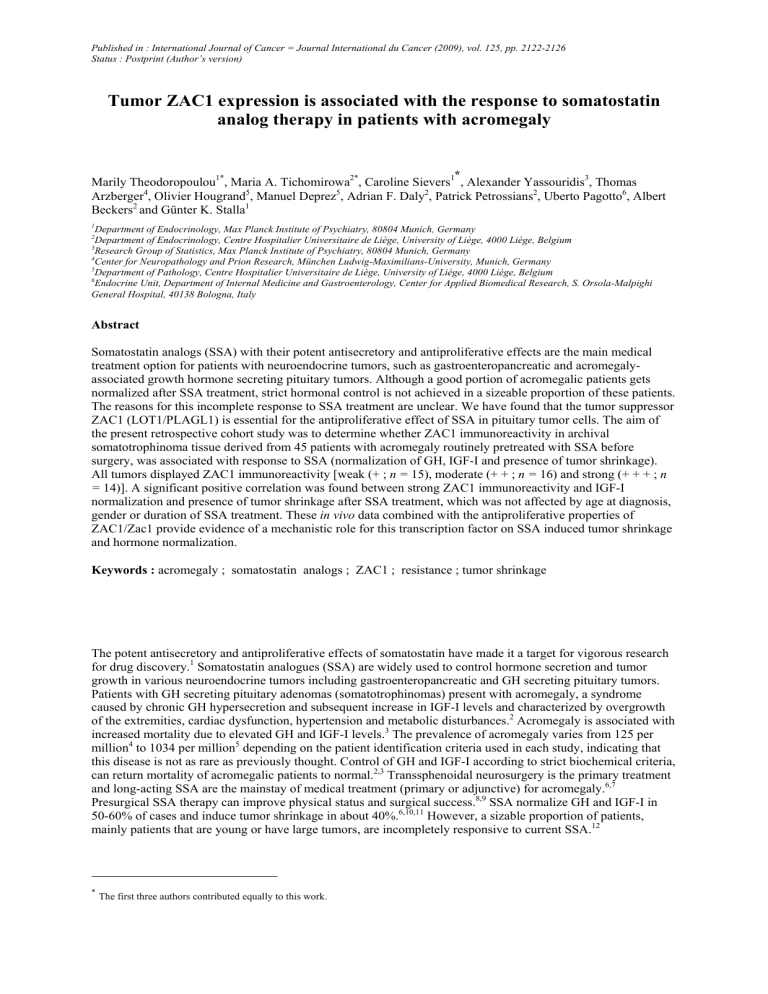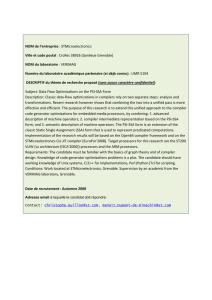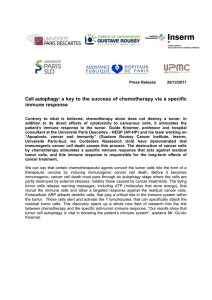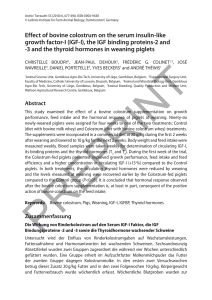Open access
publicité

Published in : International Journal of Cancer = Journal International du Cancer (2009), vol. 125, pp. 2122-2126 Status : Postprint (Author’s version) Tumor ZAC1 expression is associated with the response to somatostatin analog therapy in patients with acromegaly * Marily Theodoropoulou1*, Maria A. Tichomirowa2*, Caroline Sievers1 , Alexander Yassouridis3, Thomas Arzberger4, Olivier Hougrand5, Manuel Deprez5, Adrian F. Daly2, Patrick Petrossians2, Uberto Pagotto6, Albert Beckers2 and Günter K. Stalla1 1 Department of Endocrinology, Max Planck Institute of Psychiatry, 80804 Munich, Germany Department of Endocrinology, Centre Hospitalier Universitaire de Liège, University of Liège, 4000 Liège, Belgium Research Group of Statistics, Max Planck Institute of Psychiatry, 80804 Munich, Germany 4 Center for Neuropathology and Prion Research, München Ludwig-Maximilians-University, Munich, Germany 5 Department of Pathology, Centre Hospitalier Universitaire de Liège, University of Liège, 4000 Liège, Belgium 6 Endocrine Unit, Department of Internal Medicine and Gastroenterology, Center for Applied Biomedical Research, S. Orsola-Malpighi General Hospital, 40138 Bologna, Italy 2 3 Abstract Somatostatin analogs (SSA) with their potent antisecretory and antiproliferative effects are the main medical treatment option for patients with neuroendocrine tumors, such as gastroenteropancreatic and acromegalyassociated growth hormone secreting pituitary tumors. Although a good portion of acromegalic patients gets normalized after SSA treatment, strict hormonal control is not achieved in a sizeable proportion of these patients. The reasons for this incomplete response to SSA treatment are unclear. We have found that the tumor suppressor ZAC1 (LOT1/PLAGL1) is essential for the antiproliferative effect of SSA in pituitary tumor cells. The aim of the present retrospective cohort study was to determine whether ZAC1 immunoreactivity in archival somatotrophinoma tissue derived from 45 patients with acromegaly routinely pretreated with SSA before surgery, was associated with response to SSA (normalization of GH, IGF-I and presence of tumor shrinkage). All tumors displayed ZAC1 immunoreactivity [weak (+ ; n = 15), moderate (+ + ; n = 16) and strong (+ + + ; n = 14)]. A significant positive correlation was found between strong ZAC1 immunoreactivity and IGF-I normalization and presence of tumor shrinkage after SSA treatment, which was not affected by age at diagnosis, gender or duration of SSA treatment. These in vivo data combined with the antiproliferative properties of ZAC1/Zac1 provide evidence of a mechanistic role for this transcription factor on SSA induced tumor shrinkage and hormone normalization. Keywords : acromegaly ; somatostatin analogs ; ZAC1 ; resistance ; tumor shrinkage The potent antisecretory and antiproliferative effects of somatostatin have made it a target for vigorous research for drug discovery.1 Somatostatin analogues (SSA) are widely used to control hormone secretion and tumor growth in various neuroendocrine tumors including gastroenteropancreatic and GH secreting pituitary tumors. Patients with GH secreting pituitary adenomas (somatotrophinomas) present with acromegaly, a syndrome caused by chronic GH hypersecretion and subsequent increase in IGF-I levels and characterized by overgrowth of the extremities, cardiac dysfunction, hypertension and metabolic disturbances.2 Acromegaly is associated with increased mortality due to elevated GH and IGF-I levels.3 The prevalence of acromegaly varies from 125 per million4 to 1034 per million5 depending on the patient identification criteria used in each study, indicating that this disease is not as rare as previously thought. Control of GH and IGF-I according to strict biochemical criteria, can return mortality of acromegalic patients to normal.2,3 Transsphenoidal neurosurgery is the primary treatment and long-acting SSA are the mainstay of medical treatment (primary or adjunctive) for acromegaly.6,7 Presurgical SSA therapy can improve physical status and surgical success.8,9 SSA normalize GH and IGF-I in 50-60% of cases and induce tumor shrinkage in about 40%.6,10,11 However, a sizable proportion of patients, mainly patients that are young or have large tumors, are incompletely responsive to current SSA.12 * The first three authors contributed equally to this work. Published in : International Journal of Cancer = Journal International du Cancer (2009), vol. 125, pp. 2122-2126 Status : Postprint (Author’s version) Somatostatin binds to a family of receptors (SSTR1-5), which belong to the 7-transmembrane-domain G-protein coupled receptors (GPCR13). The most commonly used SSA, octreotide and lanreotide, primarily bind to SSTR2 and with less affinity to SSTR5. Somatostatin and its analogues exert their antiproliferative effects by causing cell cycle arrest14,15 and/or apoptosis.16 In a previous study, we have demonstrated that octreotide mediates its antiproliferative action in a pituitary tumor cell model by inhibiting the PI3K/Akt survival pathway and inducing the expression of the tumor suppressor ZAC1/Zac1.17 ZAC1 is a zinc finger transcription factor highly expressed in the normal pituitary but downregulated in the majority of pituitary adenomas.18 Octreotide failed to suppress cell viability in pituitary tumor cells in which Zac1 was knocked-down, suggesting the importance of this factor in SSA antiproliferative action. This study was undertaken to assess whether ZAC1 expression levels in somatotropinomas were associated with hormonal and tumor shrinkage responses to SSA therapy in patients with acromegaly. Material and methods Patients The data for this study were drawn from the relational database, the Liège Acromegaly Survey (LAS, Graphmed, Liège, Belgium). The LAS contains data from patients with acromegaly treated at the Centre Hospitalier Universitaire, Liège, Belgium over the period 1970-2006. Among these patients, 123 consecutive patients received SSAs. Data from 75 patients were excluded from this study due to: lack of MRI scans at diagnosis and post-treatment (n = 33), lack of tumor sample (n = 18), primary medical therapy (n = 10), use of dopamine agonists (n = 8) and previous radiotherapy (n = 6). The initial study cohort comprised data from 48 patients. Acromegaly was diagnosed following the failure to suppress plasma GH to <2 µg/L during a 2 hr oral glucose tolerance test (OGTT), in addition to an elevated IGF-I level for age and sex. All 48 patients underwent transphenoidal neurosurgery; in 3 cases where patients underwent a second surgery for tumor re-growth, the second operative sample was studied. One patient had multiple endocrine neoplasia type 1 (MEN-1). Tumor characteristics Tumor samples from 48 patients were identified. Histopathological studies showed that 43 tumors stained positive for GH (24 GH alone, 16 mixed GH/prolactin and 3 plurihormonal). In 2 cases, no histopathological diagnosis was available. Three cases were histologically diagnosed as oncocytomas and were excluded from the study. Therefore, the final study cohort consisted of 45 patients. This study was approved by the ethics committee of the University of Liège. SSA treatment The mean duration of preoperative SSA therapy was 7.5 ± 6.2 months (range: 4-38 months). Three patients who underwent a second intervention had received SSAs only before the second intervention. Octreotide acetate s.c. (Sandostatin®, N.V. Novartis Pharma S.A., Vilvoorde, Belgium) was used in 26 patients (dose: 300-1500 mg/day), and 2 patients received octreotide LAR (dose: 20-30 mg/28 days). In the patients receiving intermittent s.c. octreotide, treatment was discontinued 1-4 days before surgery, while those treated with octreotide LAR, the final dose was given less than a month before surgery. Fourteen patients received 20-30 mg of long acting lanreotide (Somatuline LA®, Ipsen NV, Merelbeke, Belgium) every 10-14 days and treatment was ceased ~10 days before surgery; 3 others received lanreotide Autogel (dose: 60-120 mg/28 days) and treatment stopped less than a month before surgery. GH and IGF-I measurements GH and IGF-I levels were determined at diagnosis (following a 2 hr OGTT) and the last value at the end of preoperative SSA therapy, before the patient underwent surgery. The cut-off value for normalization of GH was ≤2.0 µg/L. Because of the variety of assays used over time, IGF-I data were expressed for each assay as a percentage of the upper limit of normal (ULN) values for age and sex. Thus, the cut-off value for normalization of IGF-I was 100%. Published in : International Journal of Cancer = Journal International du Cancer (2009), vol. 125, pp. 2122-2126 Status : Postprint (Author’s version) Radiological data Tumor size was evaluated by MRI at the time of diagnosis and after preoperative SSA therapy. Changes in tumor size were classified as no change or shrinkage (≥15% decrease in maximum diameter). All the images were viewed by the same experienced neuroradiologist and changes in tumor size were verified independently by a second experienced reviewer. The cut-off of 15% was chosen in accordance with criteria used in previous studies.7,8 ZAC1 immunohistochemistry For ZAC1 determination, 4 µm paraffin sections of tumor samples were used. Antigen retrieval was performed by microwave heating for 15 min in 10 mM citrate buffer at a pH of 6.0. ZAC1 immunohistochemistry was performed as previously described18 and immunoreactivity was determined by 2 independent investigators. The ZAC1 staining intensity pattern was classified as: weak (+), moderate (+ +) and strong (+ + +). A normal human pituitary from an autopsy case taken 12 hr after sudden death (no evidence of a pituitary adenoma or other endocrine disease) was used as a positive control. For negative controls, the primary antibody was omitted. Statistics Statistical analysis was performed using SPSS version 15.0 (SPSS, Chicago, IL). Tumors were classified into 3 groups according to their ZAC1 immunoreactivity (+ , ++ and + + +, respectively). The response to SSAs in terms of GH was classified as 1 (≤2.0 µg/L) or 0 (no normalization). The response to SSAs in terms of IGF-I was classified as 1 (≤100% of the ULN for age and sex) or 0 (>100% of the ULN for age and sex). Changes in tumor size were classified as 0 (no change) or 1 (shrinkage; ≥15% decrease in maximum diameter). Tumor histology was classified as 0 (GH only), 1 (mixed GH-PRL) and 2 (plurihormonal). Fisher's exact test with chi-square statistics and Spearman rank test were used to assess the homogeneity of the frequency distribution of discrete or nominal parameters within the ZAC1 immunoreactivity groups. Associations between these parameters and ZAC1 immunoreactivity were confirmed using Somer's D-test. For continuous parameters, differences in their means between the 3 ZAC1 groups were tested for significance by analysis of variance (ANOVA). The p < 0.05 was considered to be statistically significant. TABLE I - PATIENT CHARACTERISTICS OF THE STUDY COHORT Variables % Demographics Male 24 53.3 Female 21 46.7 Mean age at diagnosis, year (SD) 45.8 (12.8) Histology GH 24 53.3 Mixed GH/PRL 16 35.6 Plurihormonal 3 6.7 Unknown 2 4.4 Baseline laboratory values (diagnosis) Mean GH µg/L (SD) 29.3 (±29.2) MeanIGF-1%(SD) 226.1 (±107.8) Tumor shrinkage No 21 46.7 Yes 24 53.3 GH normalization No 23 51.1 Yes 22 48.9 IGF-1 normalization No 21 46.7 Yes 24 53.3 SD, standard deviation. Published in : International Journal of Cancer = Journal International du Cancer (2009), vol. 125, pp. 2122-2126 Status : Postprint (Author’s version) Results Patient characteristics are shown in Table I. There were 24 men and 21 women; the mean age at diagnosis was 46.8 ± 12.6 years (range 18-67 years). The mean baseline GH level in the study group was 29.3 µg/L and the mean baseline IGF-I was 226.1% of the ULN for age and sex. Tumor shrinkage occurred with SSA therapy in 53.3% of cases; GH and IGF-I normalization was seen in 48.9% (22/45) and 53.3% (24/45) cases, respectively. All tumors displayed nuclear ZAC1 immunoreactivity, which varied in intensity across weak (+ ; n = 15), moderate (+ +; n = 16) and strong (+ + + ; n = 14) groups (examples of each intensity are displayed in Fig. 1). Characteristics of the different ZAC1 immunostaining groups are shown in Table II. None of the acromegalic tumors examined were found negative for ZAC1, and the intensity of ZAC1 immunoreactivity was assessed against patient's characteristics and SSA treatment outcome. Associations with ZAC1 immunoreactivity Age and gender. The intensity of ZAC1 immunoreactivity was not related with gender (Fisher's exact test: p = 0.3865) or age at diagnosis (ANOVA: p = 0.967). GH and IGF-I A significant association existed between ZAC1 expression and normalization of IGF-I levels (Fisher's exact test, p = 0.0027; Fig. 2). This correlation was confirmed using Spearman rank test (r = 0.517, p < 0.0001) and Somer's D-test (D = 0.56, p = 0.0005). Tumors with moderate ZAC1 immunoreactivity show a higher probability to respond to SSA compared with "weak" tumors, but not as high as "strong" tumors (Fig. 2b). No association was seen between ZAC1 and GH normalization (Fisher's exact test: p = 0.36; Spearman rank test: r = 0.0019, p = 0.99; Somer's D-test: D = 0.002, p = 1.000). Tumor shrinkage Tumor shrinkage after SSA treatment was significantly associated with ZAC1 expression (Fisher's exact test, p = 0.0028; Somer's D-test D = 0.52, p = 0.0011), which was confirmed using the Spearman rank test (r = 0.476, p = 0.001). Tumors with moderate ZAC1 immunoreactivity were found to correlate similarly with those having strong ZAC1 immunoreactivity in terms of tumor shrinkage (Table II). Other parameters ZAC1 expression did not correlate with tumor histology (Fisher's exact test: p = 0.68), initial GH (p = 0.97), initial IGF-I (p = 0.87) or preoperative SSA treatment duration (p = 0.094). Published in : International Journal of Cancer = Journal International du Cancer (2009), vol. 125, pp. 2122-2126 Status : Postprint (Author’s version) TABLE II - PATIENT CHARACTERISTICS ACCORDING TO ZAC1 IMMUNOREACTIVITY: WEAK, MODERATE AND STRONG ZAC1 Weak Medium Strong p-values D and p-values immunoreactivity (+) (++) (+++) Total 15 16 14 Gender Female 8 9 4 0.38650 D = 0.18634. Male 7 7 10 p = 0.2981 Histology GH 8 7 8 0.68498 D = 0.06034. Mixed 6 6 4 p = 0.6906 Other 2 2 n.a. 1 1 Tumor shrinkage Yes 2 11 10 0.0028 D = 0.52193. No 13 4 4 p = 0.0011 GH normalization Yes (≤2.0) 6 10 6 0.36034 D = 0.00207. No 9 6 8 p = 1.0000 IGF-I normalization Yes 3 9 12 0.0027 D = 0.56315. No 12 7 2 p = 0.0005 p-values ANOVA F-values DF: 2, 42 Age at diagnosis 46.33 ± 12.9 46.63 ± 13.99 47.15 ± 11.49 0.967 0.103 Treatment duration 6.20 ± 2.60 6.19 ± 2.26 10.07 ± 10.68 0.094 2.409 Initial GH 30.64 ± 30.07 30.35 ± 34.19 26.54 ± 23.67 0.975 0.089 Initial IGF-I 217.43 ± 74.92 239.00 ± 90.47 220.62 ± 154.20 0.871 0.364 ∆-GH 22.30 ± 27.32 21.87 ± 24.89 18.84 ± 16.25 0.961 0.071 ∆-IGF-I 64.29 ± 106.44 60.27 ± 128.31 144.31 ± 154.06 0.150 1.498 r/p3 r = 0.05972. p = 0.7151 r = 0.47663. p = 0.0010 r = 0.00193. p = 0.9902 r = 0.51740. p < 0.0001 The statistical correlation between patient characteristic and ZAC1 immunoreactivity is shown as Fisher's exact probability test (p), Sommer's D-test (D and p) and Spearman's rank correlation coefficient (r/p). DF, degree of freedom; n.a., not available. 1Fisher's Exact test.2 Somer's D-test.-3Spearman's test. Figure 1 - ZAC1 immunoreactivity in archival paraffin-embedded acromegalic tumors. In the figure are depicted examples of acromegalic tumors with weak (a), moderate (b) and strong (c) nuclear ZAC1 immunoreactivity. Published in : International Journal of Cancer = Journal International du Cancer (2009), vol. 125, pp. 2122-2126 Status : Postprint (Author’s version) Figure 2 - (a) Graph showing the distribution of the individual final IGF-I values, determined after completion of SSA treatment and before surgery, among the 3 groups of ZAC1 immunoreactivity. IGF-I values are expressed as a percentage of the upper limit of normal (ULN) values for age and sex. The cut-off value for normalization of IGF-I was 100%. (b) Frequency distribution of the IGF-I normalization across the ZAC1 values. Discussion ZAC1/Zac1 (also known as LOT1 and PLAGL1) is a zinc finger transcription factor that can induce apoptosis and cell cycle arrest and plays an important role in embryonic growth by regulating genes such as igf2 and p57kip2 (Cdkn1c19,20). ZAC1/Zac1 is highly expressed in the murine and human anterior pituitary, but is downregulated in the majority of pituitary adenoma subtypes. Eliminating Zac1 expression using antisense techniques increased cell proliferation in murine pituitary tumor cell lines. We recently showed that Zac1 acts downstream of SSTR2. Rat pituitary tumor cells, in which Zac1 was knocked-down by RNA interference, were resistant to octreotide's antiproliferative action. These data highlight ZAC1/Zac1 as an important component of the antiprohferative action of octreotide. In this study, we examined whether ZAC1 immunoreactivity was related to the response to SSAs in patients with acromegaly. ZAC1 expression did not correlate with age and gender confirming our previous findings.18 ZAC1 expression positively correlated with IGF-I normalization, but not with GH normalization. Nevertheless, a divergent profile in terms of GH and IGF-I control is well recognized to occur in the setting of SSA treatment.6 The reasons for the divergent results in this study may be similarly due to the difficulties in assessing true integrated 24-hr GH secretion due to the inherent pulsatility of GH. Also, ultrasensitive GH assays show that GH levels can be < 1.0 µg/L after OGTT in the setting of active acromegaly. The retrospective nature of this study meant that ultrasensitive GH assays were not uniformly available in all patients, and together these issues may have contributed to discordant results. Published in : International Journal of Cancer = Journal International du Cancer (2009), vol. 125, pp. 2122-2126 Status : Postprint (Author’s version) Interestingly, there was a positive correlation between increased ZAC1 immunoreactivity and tumor shrinkage after SSA therapy. ZAC1 immunoreactivity did not correlate with other patient characteristics, such as baseline IGF-I, baseline GH and the duration of SSA treatment. Tumor shrinkage is reported in 40-50% of acromegalic patients receiving SSA treatment.22,23 Although tumor shrinkage is a recognized effect of SSAs, the molecular mechanisms behind it have yet to be elucidated.12 SSAs were shown to inhibit cell cycle progression in vitro.15,16 Reduced Ki-67 protein levels in tumors from acromegalic patients treated with octreotide supports the concept that SSAs induce cell cycle arrest in vivo.24 Somatostatin was also shown to induce apo-ptosis, mainly through SSTR3,25 although there is evidence for the involvement of SSTR2.26 However, apoptosis was not significantly increased in octreotide-treated tumors. Furthermore no necrotic events, or other morphological changes, were found in SSA treated acromegalic tumors.27 These reported data suggest that SSA-induced tumor shrinkage is probably due to cell growth arrest rather than apoptosis. ZAC1/Zac1 limits cell growth by inducing cell cycle arrest19; therefore it can cause, at least in part, the cell cycle arrest state reported in acromegalic tumors after SSA treatment (reviewed in Ref. 23). The positive correlation between ZAC1 immunoreactivity and tumor shrinkage and decreased IGF-I levels after SSA treatment, suggest ZAC1 as a possible marker for SSA response. A reliable immunohistopafhological marker could help to guide treatment in patients with residual tumor postoperatively toward either long-term adjuvant SSA or consideration of re-operation to debulk the remaining tumor, which we and others have shown to significantly increase subsequent control with SSAs.22,28 Previous studies have shown that somatotroph tumor type can predict SSA treatment outcome, with densely granulated adenomas having a higher probability to respond to this treatment than sparsely granulated.2 Furthermore, the expression of the α-subunit of the heterotrimeric GTP-binding protein Gsα was found to be higher in octreotide-sensitive acromegalic tumors.29 In addition, the expression of the different SSTR types in responders versus nonresponders was also a subject of intense investigation. Positive SSTR autoradiography/scintigraphy correlated with octreotide's therapeutic efficacy.30-32 Furthermore, low SSTR2 expression was associated with poor hormonal response after SSA treatment33,34 and this was confirmed at protein level by finding a strong correlation between SSTR2A immunoreactivity and GH decrease after an octreotide suppression test.35 Indeed SSTR2 gene transfer to partially SSA resistant human somatotroph tumors in primary cell culture increased their response to octreotide treatment.36 In addition, a mutation in SSTR5 was found in 1 acromegalic patient resistant to octreotide treatment.37 In summary, ZAC1 immunostaining on tumor tissue was associated with tumor shrinkage and IGF-I normalization in patients with acromegaly treated with SSAs. Considering that ZAC1 is a tumor suppressor gene that plays a prominent role in the antiproliferative action of SSA, these data suggest a mechanistic role for this factor in SSA-induced tumor shrinkage and general treatment response. Zac1 was shown to be downstreams to the PI3K/Akt pathway, which plays a central role in the regulation of cell survival and growth.17 Whether ZAC1/Zac1 inhibits this pathway at transcriptional level to mediate SSA-induced tumor shrinkage is an issue that deserves further study. In addition our findings of a correlation between high ZAC1 immunoreactivity and IGF-I normalization suggests the possibility of a putative role for this transcription factor on SSA dependent decrease in hormone synthesis. The herein reported in vivo study points to a central role for ZAC1 in SSA action and raises several issues, the elucidation of which will facilitate the better understanding of SSA action and will subsequently lead to improvements in SSA treatment efficacy. Acknowledgements The authors thank Dr. Thomas Barz and Dr. Dietmar Spengler for kindly providing the ZAC1/Zac1 antibody (described in Ref. 38) and Angelika Henn (Grosshadern, Munich, Germany) for her valuable assistance in processing the tumor samples. This work was supported by a grant from the Deutsche Forschungsgemeinschaft (to M.T.) and a research grant from the Novartis Pharma GmbH, Nürnberg, Germany (to G.K.S.). Grant sponsor: Deutsche Forschungsgemeinschaft; Grant number: TH 901/1-3. Grant sponsor: Novartis Pharma GmbH. References 1. Weckbecker G, Lewis I, Albert R, Schmid HA, Hoyer D, Brans C. Opportunities in somatostatin research: biological, chemical and therapeutic aspects. Nat Rev Drug Discov 2003;2:999-1017. Published in : International Journal of Cancer = Journal International du Cancer (2009), vol. 125, pp. 2122-2126 Status : Postprint (Author’s version) 2. Melmed S. Acromegaly. N Engl J Med 2006;355:2558-73. 3. Dekkers OM, Biermasz NR, Pereira AM, Romijn JA, Vandenbroucke JP. Mortality in acromegaly: a metaanalysis. J Clin Endocrinol Metab 2008;93:61-7. 4. Daly AF, Rixhon M, Adam C, Dempegioti A, Tichomirowa MA, Beckers A. High prevalence of pituitary adenomas: a cross-sectional study in the province of liège. Belgium. J Clin Endocrinol Metab 2006;91:4769-75. 5. Schneider HJ, Sievers C, Sailer B, Wittchen HU, Stalk GK. High prevalence of biochemical acromegaly in primary care patients with elevated IGF-1 levels. Clin Endocrinol (Oxf) 2008;69:432-5. 6. Freda PU, Katznelson L, van der Lely AJ, Reyes CM, Zhao S, Rabinowitz D. Long-acting somatostatin analog therapy of acromegaly: a meta-analysis. J Clin Endocrinol Metab 2005;90:4465-73. 7. Cozzi R, Montini M, Attanasio R, Albizzi M, Lasio G, Lodrini S, Doneda P, Cortesi L, Pagani G. Primary treatment of acromegaly with octreotide LAR: a long-term (up to nine years) prospective study of its efficacy in the control of disease activity and tumor shrinkage. J Clin Endocrinol Metab 2006;91:1397-403. 8. Stevenaert A, Beckers A. Presurgical octreotide: treatment in acromegaly. Metabolism 1996;45(8 Suppl 1):72-4. 9. Beckers A. Does preoperative somatostatin analog treatment improve surgical cure rates in acromegaly? A new look at an old question. J Clin Endocrinol Metab 2008;93:2975-7. 10. Bevan JS. The antitumoral effects of somatostatin analog therapy in acromegaly. J Clin Endocrinol Metab 2005;90:1856-63. 11. Melmed S, Steinberg R, Cook D, Klibanski A, Chanson P, Bonert V, Vance ML, Rhew D, Kleinberg D, Barkan A. A critical analysis of pituitary tumor shrinkage during primary medical therapy in acromegaly. J Clin Endocrinol Metab 2005;90:4405-10. 12. Besser GM, Burman P, Daly AF. Predictors and rates of treatment-resistant tumor growth in acromegaly. Eur J Endocrinol 2005;153:187-93. 13. Patel YC, Greenwood MT, Panetta R, Demchyshyn L, Niznik H, Srikant CB. The somatostatin receptor family. Life Sci 1995;57:124965. 14. Cheung NW, Boyages SC Somatostatin-14 and its analog octreotide exert a cytostatic effect on GH3 rat pituitary tumor cell proliferation via a transient G0/G1 cell cycle block Endocrinology 1995;136:4174-81. 15. Srikant CB. Cell cycle dependent induction of apoptosis by somatostatin analog SMS 201-995 in AtT-20 mouse pituitary cells. Biochem Biophys Res Commun 1995;209:400-6. 16. Sharma K, Srikant CB. Induction of wild-type p53, Bax, and acidic endonuclease during somatostatin-signaled apoptosis in MCF-7 human breast cancer cells. Int J Cancer 1998;76:259-66. 17. Theodoropoulou M, Zhang J, Laupheimer S, Paez-Pereda M, Erneux C, Florio T, Pagotto U, Stalla GK. Octreotide, a somatostatin analogue, mediates its antiproliferative action in pituitary tumor cells by altering phosphatidylinositol 3-kinase signaling and inducing Zac1 expression. Cancer Res 2006;66:1576-82. 18. Pagotto U, Arzberger T, Theodoropoulou M, Grübler Y, Pantaloni C, Saeger W, Losa M, Journot L, Stalla GK, Spengler D. The expression of the antiproliferative gene ZAC is lost or highly reduced in nonfunctioning pituitary adenomas. Cancer Res 2000;60:6794-99. 19. Spengler D, Villalba M, Hoffmann A, Pantaloni C, Houssami S, Bockaert J, Journot L. Regulation of apoptosis and cell cycle arrest by Zac1, a novel zinc finger protein expressed in the pituitary gland and the brain. EMBO J 1997;16:2814-25. 20. Varrault A, Gueydan C, Delalbre A, Bellmann A, Houssami S, Aknin C, Severac D, Chotard L, Kahli M, Le Digarcher A, Pavlidis P, Journot L. Zac1 regulates an imprinted gene network critically involved in the control of embryonic growth. Dev Cell 2006;11:711-22. 21. Pagotto U, Arzberger T, Ciani E, Lezoualc'h F, Pilon C, Journot L, Spengler D, Stalla GK. Inhibition of Zac1, a new gene differentially expressed in the anterior pituitary increases cell proliferation. Endocrinology 1999;140:987-96. 22. Colao A, Attanasio R, Pivonello R, Cappabianca P, Cavallo LM, Lasio G, Lodrini A, Lombardi G, Cozzi R. Partial surgical removal of growth hormone-secreting pituitary tumors enhances the response to somatostatin analogs in acromegaly. J Clin Endocrinol Metab 2006;91:85-92. 23. Bhayana S, Booth GL, Asa SL, Kovacs K, Ezzat S. The implication of somatotroph adenoma phenotype to somatostatin analog responsiveness in acromegaly. J Clin Endocrinol Metab 2005;90:6290-5. 24. Losa M, Ciccarelli E, Mortini P, Barzaghi R, Gaia D, Faccani G, Papotti M, Mangi]i F, Terreni MR, Camanni F, Giovanelli M. Effects of octreotide treatment on the proliferation and apoptotic index of GH-secreting pituitary adenomas. J Clin Endocrinol Metab 2001;86:5194200. Published in : International Journal of Cancer = Journal International du Cancer (2009), vol. 125, pp. 2122-2126 Status : Postprint (Author’s version) 25. Sharma K, Patel YC, Srikant CB. Subtype-selective induction of wild-type p53 and apoptosis, but not cell cycle arrest, by human somatostatin receptor 3. Mol Endocrinol 1996;10:1688-96. 26. Ferrante E, Pellegrini C, Bondioni S, Peverelli E, Locatelli M, Gelmini P, Luciani P, Peri A, Mantovani G, Bosari S, Beck-Peccoz P, Spada A, et al. Octreotide promotes apoptosis in human somatotroph tumor cells by activating somatostatin receptor type 2. Endocr Relat Cancer 2006;13:955-62. 27. Ezzat S, Horvath E, Harris AG, Kovacs K. Morphological effects of octreotide on growth hormone-producing pituitary adenomas. J Clin Endocrinol Metab 1994;79:113-8. 28. Petrossians P, Borges-Martins L, Espinoza C, Daly A, Betea D, Valdes-Socin H, Stevenaert A, Chanson P, Beckers A. Gross total resection or debulking of pituitary adenomas improves hormonal control of acromegaly by somatostatin analogs. Eur J Endocrinol 2005;152:61-6. 29. Picard C, Silvy M, Gerard C, Buffat C, Lavaque E, Figarella-Branger D, Dufour H, Gabert J, Beckers A, Brue T, Enjalbert A, Barlier A. Gs alpha overexpression and loss of Gs alpha imprinting in human somatotroph adenomas: association with tumor size and response to pharmacologic treatment. Int J Cancer 2007;121:1245-52. 30. Reubi JC, Landolt AM. The growth-hormone responses to octreotide in acromegaly correlate with adenoma somatostatin receptor status. J Clin Endocrinol Metab 1989;68:844-50. 31. Bertherat J, Chanson P, Dewailly D, Enjalbert A, Jaquet P, Kordon C, Peillon F, Timsit J, Epelbaum J. Resistance to somatostatin (SRIH) analog therapy in acromegaly. Re-evaluation of the correlation between the SRIH receptor status of the pituitary tumor and the in vivo inhibition of GH secretion in response to SRIH analog. Horm Res 1992;38:94-9. 32. Broson-Chazot F, Houzard C, Ajzenberg C, Nocaudie M, Duet M, Mundler O, Marchandise X, Epelbaum J, Gomez De Alzaga M, Schafer J, Meyerhof W, Sassolas G, et al. Somatostatin receptor imaging in somatotroph and non-functioning pituitary adenomas: correlation with hormonal and visual responses to octreotide. Clin Endocrinol (Oxf) 1997;47:589-98. 33. Barlier A, Pellegrini-Bouiller I, Gunz G, Zamora AJ, Jaquet P, Enjalbert A. Impact of gsp oncogene on the expression of genes coding for Gsα, Pit-1, Gi2α, and somatostatin receptor 2 in human somatotroph adenomas: involvement in octreotide sensitivity. J Clin Endocrinol Metab 1999;84:2759-65. 34. Jaquet P, Saveanu A, Gunz G, Fina F, Zamora AJ, Grino M, Culler MD, Moreau JP, Enjalbert A, Ouafik LH. Human somatostatin receptor subtypes in acromegaly: distinct patterns of messenger ribonucleic acid expression and hormone suppression identify different tumoral phenotypes. J Clin Endocrinol Metab 2000;85:781-92. 35. Takei M, Suzuki M, Kajiya H, Ishii Y, Tahara S, Miyakoshi T, Egashira N, Takekoshi S, Sanno N, Teramoto A, Osamura RY. Immunohistochemical detection of somatostatin receptor (SSTR) subtypes 2A and 5 in pituitary adenoma from acromegalic patients: good correlation with preoperative response to octreotide. Endocr Pathol 2007; 18:208-16. 36. Acunzo J, Thirion S, Roche C, Saveanu A, Gunz G, Germanetti AL, Couderc B, Cohen R, Figarella-Branger D, Dufour H, Brue T, Enjalbert A, et al. Somatostatin receptor sst2 decreases cell viability and hormonal hypersecretion and reverses octreotide resistance of human pituitary adenomas. Cancer Res 2008;68:10163-70. 37. Ballarè E, Persani L, Lank AG, Filopanti M, Giammona E, Corbetta S, Mantovani S, Arosio M, Beck-Peccoz P, Faglia G, Spada A. Mutation of somatostatin receptor type 5 in an acromegalic patient resistant to somatostatin analog treatment. J Clin Endocrinol Metab 2001; 86:3809-14. 38. Barz T, Hoffmann A, Panhuysen M, Spengler D. Peroxisome proliferator-activated receptor (gamma) is a zac target gene mediating zac antiproliferation. Cancer Res 2006;66:11975-82.













